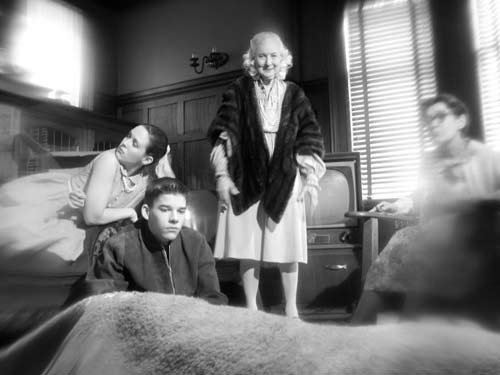My Winnipeg (12A)
Guy Maddin's homage to his home town of Winnipeg is an outstanding and often hilarious piece of film-making

This reviews section, you'll have noticed, operates a five-tier ratings system, but there are occasions when this just doesn't suffice.
Once in a blue moon, you encounter a film so extraordinary that it's not enough to award the icon of a woman standing, hands raised in applause. You really need her to be levitating several feet above her armchair, body racked with the transcendental ecstasies of Saint Teresa.
Such a film is My Winnipeg, by Canadian film-maker Guy Maddin. Yes, it's a brief, black-and-white autobiographical essay on the film-maker's home town, an often snowbound burgh in distant Manitoba. But it's also a Guy Maddin film, which means it resembles no documentary you've seen. In numerous features and shorts, Maddin has specialised in delirious pastiches of assorted styles from film history, from the silent era to the Fifties. His work includes a six-minute encapsulation of Soviet-era science fiction that's possibly the most sheerly frenetic film ever made, a tribute to the Symbolist painter Odilon Redon, and a ballet version of Dracula. It says everything about Maddin that his most narratively conventional film, The Saddest Music in the World, starred Isabella Rossellini as a brewery owner whose glass legs are filled with beer.
Maddin's new film comes across as a lantern lecture by a dotty uncle who insists on getting shamelessly self-revelatory amid all the Winnipeg municipal lore. As well as a potted history of Maddin's home town, the film is a portrait of its maker, and his oddness and Winnipeg's are often hard to untangle. Narrated by Maddin in voice-over, the film begins as a phantasmal train ride, with Maddin's on-screen alter ego (Darcy Fehr) rolling through the streets of Winnipeg's eternal night, accompanied by a wagon-load of dreamers and drunks. As black-and-white footage – some archival, some shot by director of photography Jody Shapiro – scrolls past the train windows, Maddin dreams of escape, and of the Winnipeggers, a people "stupefied by nostalgia". Swarming with sleepwalkers, Winnipeg's night is haunted by silhouettes stumbling through snowy streets, wandering into the homes of former loved ones – as permitted, Maddin claims, by Winnipeg law.
Maddin's musings on the city, and its supposedly mystical confluence of rivers, are poetic, incantatory – "The Forks, the Red, the Assiniboine ..." – and parodically Freudian to the point of hysteria. As Maddin mutters about the "lap" made by the rivers, a naked female crotch is superimposed on the city map, before an aged matriarch looms up to scowl disapprovingly at the camera.
To get Winnipeg out of his system, and himself out of Winnipeg, Maddin reconstructs his childhood, renting his old family home, where his mother and aunt ran a beauty parlour. He hires actors to play his siblings, while his mother presides over the old domestic rituals, such as the daily straightening of the hall runner, a task of Sisyphean futility. With Guy's late father symbolically buried in the living room, the family settles down to watch a long-running TV serial: LedgeMan!, a daily saga about an oversensitive soul daily talked out of suicide by his long-suffering mother, Mrs Maddin herself.
In fact, Mrs Maddin – cast in a magnificently perverse twist of inspiration – is played by octogenarian Ann Savage, who in 1945 starred in the classic thriller Detour, making her mark as film noir's cruellest and most predatory femme fatale. Even more unnerving today, Savage plays a monstrous mother who could give Joan Crawford a run for her money. In one scene, her giant image peers into a train window like King Kong into a skyscraper; in another, she humiliates Guy's teenage sister with a brutally salacious inquisition into her sex life.
We learn a startling amount about young Guy's sexual development: about the early impression made on him by the inmates of St Mary's Academy for Girls, about the smells and sounds of the "gynocracy" that was his mother's salon, about the homoerotic traumas of the boys-only section at the local swimming bath, two storeys underground. We also learn a great deal about Winnipeg history, some true, some surely invented, much of it re-enacted for the camera.
We learn of the city's socialist heyday, of its invasion by Nazis (in reality, Rotarians staging a simulation to help the war effort), of its league of superannuated hockey legends, of bacchanalian muscle-boy pageants, gay bison, spiritualist ballet meetings. Strangest of all, told partly in shadow-puppet animation, is the tale of the runaway horses that froze to death in the Red River, their heads sticking out of the ice "like 11 knights on a vast white chessboard"; this episode, I've been assured, really is true.

Watch Apple TV+ free for 7 days
New subscribers only. £8.99/mo. after free trial. Plan auto-renews until cancelled

Watch Apple TV+ free for 7 days
New subscribers only. £8.99/mo. after free trial. Plan auto-renews until cancelled
Dream, confession, civic history and home movies all merge together – "seamlessly", I would have said, if John Gurdebeke's editing weren't so wildly kinetic, as if the film were spilling directly from Maddin's unconscious while on a hypnotist's couch. Exclamatory, often outrageous captions punctuate the storm of images: "Passive aggressive!" – "Man-Sweat!" – "Ectoplasm!" – "Orange Jello!". Who would have thought that such a seemingly marginal city as Winnipeg would establish itself effortlessly as the world capital of Surrealist free association?
Probably the only film ever to mix Freud, Proust and a love of ice hockey, My Winnipeg is a joyous, mischievous, hilarious flight of fancy. It's also a strangely profound demonstration of the way film can reanimate faded memory and bring ghosts back to life. Flying in the face of a much-loved American motto, My Winnipeg uses some of cinema's simplest and most eloquent resources to prove that, in film, you actually can go home again.
Join our commenting forum
Join thought-provoking conversations, follow other Independent readers and see their replies
Comments